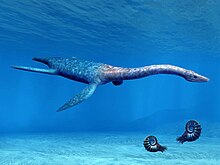|
Attenborosaurus
Attenborosaurus is an extinct genus of pliosaurid from the Early Jurassic of Dorset, England. The type species is A. conybeari. The genus is named after David Attenborough,[1] the species after William Conybeare.[2] History The original remains of the holotype, specimen, were discovered in Charmouth, Dorset, England in 1880[3] and was described in 1881.[2] This original specimen was housed at the Bristol City Museum and Art Gallery[2] where it stayed until it was destroyed in November 1940, during World War II.[1] Thankfully, before the war, a cast had been made by William Johnson Sollas, c. 1888 and sent to the Natural History Museum in London. This specimen (specimen NHMUK PV R1339) is still housed at the Natural History Museum, London along with two referred specimens: specimen NHMUK OR 39514 which includes part of the skull; and specimen NHMUK OR 40140 which includes a skull and postcrania and was purchased by E.C. Day in 1866, also from Dorset.[3] Specimens NHMUK PV R 1339 and NHMUK OR 40140 are both on public display in Fossil Way at the museum (although NHMUK OR 40140 is mislabeled as "40140/R1360"). At first the animal was thought to be another Plesiosaurus species by William Johnson Sollas in 1881,[2] but after studies on the plaster casts made after the remains, Plesiosaurus conybeari was assigned to a new genus (Attenborosaurus) by Robert T. Bakker in 1993.[1] Description Judging by the holotype, which is the partial remains of one single specimen, the length of the animal was about 4.3 m (14 ft).[2][4] Much like its plesiosaur cousins, it was piscivorous. From the skin impression found with the bones, which was later destroyed, it is presumed that the creature had membranous skin, devoid of any significantly large scales, probably for decreasing water resistances.[1] ClassificationThe following cladogram follows an analysis by Benson & Druckenmiller (2014).[5] See also
References
External linksWikimedia Commons has media related to Attenborosaurus. |
||||||||||||||||||||||||||||||||||







